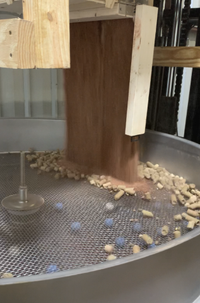Challenge:
ScreenerKing was recently approached by a new customer in the agricultural feed industry who was having issues with a pass-through sifter setup they were using to scalp oversized particles from their mineral feed mix prior to bagging.
The customer had an extremely high target throughput volume of 1,500 pounds per minute processed through a 4 mesh screen. Their existing setup, supplied by one of the largest companies in the vibratory separator space, had continuous failures of the machine frames, perforated steel plates, and foot-mounted motors used to generate the vibration. These issues often produce downtime in a critical production process that reduces the volume of sellable material and adds increased material and labor expenses to resolve the issues.
This white paper presents how ScreenerKing addressed these issues and achieved outstanding results, ensuring both machine performance and safety.
Our Approach:
Our approach to solving the customer’s issue was to confirm with absolute certainty that our largest machine setup could produce the volume required and manage a small amount of oversized material that had the right size and shape to get stuck in the 4 mesh screen.
Even though the percentage of oversized material was small, the sheer volume of overall material passing through the screen greatly exacerbated the risk of any screen blinding. This incredible volume and density of the material also posed another risk: overloading the lower frame of the machine, overburdening the motor and the springs designed to provide motion resulting in catastrophic failure of the entire machine.
We don’t currently produce material conveyance systems, so we had to fabricate something quickly to achieve the goal. Fortunately, one of Lyon Smith’s hobbies is woodworking, and he’s had lots of experience building anything from furniture to treehouses. We quickly settled on a gravity-fed vertical hopper that could be lifted with a forklift and operated with a trap door to release the material. It took some fine-tuning to get the opening size and shape to a point that produced the desired material flow rate, but it proved to be reliable and sturdy.
Results:
- Test 1:
- The first test using standard machine frames, which have an 8” out spout mounted tangentially, quickly showed that the lower frame would be overloaded before even the initial batch of 500 pounds could be processed.
- The size of the material was a fair bit smaller than the 4 mesh so it went through the screen almost immediately, while the larger pieces (beans, corn, and pelletized feed cubes) were retained by the screen. The corn was problematic, as its oblong shape tended to get stuck if oriented vertically.
- Test 2:
- A ball tray system was added to help clean the trapped corn pieces and some extruded feed pellets as well. To achieve higher throughput volume, the standard table frame was swapped for a “Scalping frame” which has a floor that slopes toward the 12” diameter out spout mounted with a radial orientation rather than tangential
- This combination of changes yielded improved results, but only achieved about 900 pounds per minute of throughput, well short of the 1,500 pounds per minute goal. The limiting factor seemed to be the width of the exit point of the bottom frame.
- Test 3:
- To overcome this issue, we worked to design a new frame with a wider out spout and an even more reinforced, steeper sloped floor. This new frame had an initial opening of 20 inches in width and tapered to 16 inches along an oval out spout, as opposed to a round out spout.
- This greatly increased the linear span available for the material to find the out spout and exit the machine. After fine-tuning the weight settings and the positioning of where the material was fed onto the machine, the target goal was not only met but exceeded!
- With video to prove it to our customer, they excitedly purchased the machine and had it delivered and installed. Thus far, about 8 months into its use, they have had ZERO issues with any of the machine components failing, including the screen. Not only has our system produced far superior results to the previous installation, but at a much lower cost.
- Our customer is thrilled with the performance of the machine, and we are excited to have been given the opportunity to solve their problem and be more equipped to help other customers in the future.
Conclusion:
ScreenerKing's dedication to solving complex separation challenges in the agricultural feed industry resulted in a highly efficient and cost-effective solution for its customer. By optimizing machine design and addressing unique material characteristics, ScreenerKing exceeded throughput goals and ensured the longevity of its equipment. Please give us a call if you need any specific material testing, we look forward to hearing from you!




